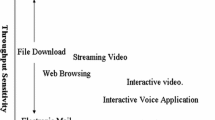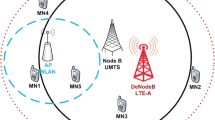Abstract
In heterogeneous wireless networks, different radio access technologies are integrated and may be jointly managed. To optimize network performance and capacity, efficient common radio resource management (CRRM) mechanisms need to be defined. This paper tackles the radio access technology (RAT) selection, a key CRRM functionality, and proposes a hybrid decision framework that dynamically integrates operator objectives and user preferences. Mobile users are assisted in their decisions by the network that broadcasts cost and QoS information. Our hybrid approach involves two inter-dependent decision-making processes. The first one, on the network side, consists in deriving appropriate network information so as to guide user decisions in a way to meet operator objectives. The second one, where individual users combine their needs and preferences with the signaled network information, consists in selecting the RAT to be associated with in a way to maximize user utility. We first focus on the user side and present a satisfaction-based multi-criteria decision-making method. By avoiding inadequate decisions, our algorithm outperforms existing solutions and maximizes user utility. Further, we introduce two heuristic methods, namely the staircase and the slope tuning policies, to dynamically derive network information in a way to enhance resource utilization. The performance of each decision-making process, on the network and user sides, is evaluated separately through extensive simulations. A comparison of our hybrid approach with six different RAT selection schemes is also presented.






























Similar content being viewed by others
References
IEEE standard for architectural building blocks enabling network-device distributed decision making for optimized radio resource usage in heterogeneous wireless access networks. IEEE Std 1900.4-2009 (2009).
3GPP TS 32.521. (2010). Telecommunication Management; Self-Organizing Networks (SON) Policy Network Resource Model (NRM) Integration Reference Point (IRP); Requirements.
Aryafar, E., Keshavarz-Haddad, A., Wang, M., & Chiang, M. (2013). RAT selection games in HetNets. In Proceedings of IEEE conference on computer communications (INFOCOM).
Bari, F., & Leung, V. C. (2007). Automated network selection in a heterogeneous wireless network environment. IEEE Networks, 21(1), 34–40.
Chamodrakas, I., & Martakos, D. (2012). A utility-based fuzzy TOPSIS method for energy efficient network selection in heterogeneous wireless networks. Applied Soft Computing, 12(7), 1929–1938.
Coupechoux, M., Kelif, J. M., & Godlewski, P. (2008). Network controlled joint radio resource management for heterogeneous networks. In Proceedings of IEEE vehicular technology conference (VTC Spring).
Coupechoux, M., Kelif, J. M., & Godlewski, P. (2008). SMDP approach for JRRM analysis in heterogeneous networks. In Proceedings of European wireless conference (EW).
Dhahri, C., & Ohtsuki, T. (2012). Learning-based cell selection method for femtocell networks. In Proceedings of IEEE vehicular technology conference (VTC Spring).
Dhahri, C., & Ohtsuki, T. (2012). Q-learning cell selection for femtocell networks: Single- and multi-user case. In Proceedings of IEEE global communications conference (GLOBECOM).
Edell, R., & Varaiya, P. (1999). Providing internet access: What we learn from INDEX. IEEE Network, 13(5), 18–25.
El Helou, M., Ibrahim, M., Lahoud, S., & Khawam, K. (2014). Optimizing network information for radio access technology selection. In Proceedings of IEEE symposium on computers and communications (ISCC).
El Helou, M., Ibrahim, M., Lahoud, S., Khawam, K., Mezher, D., & Cousin, B. (2015). A network-assisted approach for RAT selection in heterogeneous cellular networks. IEEE Journal on Selected Areas in Communications, 33(6), 1055–1067.
Falowo, O., & Chan, H. (2011). RAT selection for multiple calls in heterogeneous wireless networks using modified TOPSIS group decision-making technique. In Proceedings of IEEE international symposium on personal indoor and mobile radio communications (PIMRC).
Gazis, V., Alonistioti, N., & Merakos, L. (2005). Toward a generic always best connected capability in integrated WLAN/UMTS cellular mobile networks (and beyond). IEEE Wireless Communications, 12(3), 20–29.
Giupponi, L., Agustí, R., Pérez-Romero, J., & Sallent, O. (2006). A framework for JRRM with resource reservation and multiservice provisioning in heterogeneous networks. Mobile Networks and Applications, 11(6), 825–846.
Gozalvez, J., Lucas-Estañ, M. C., & Sanchez-Soriano, J. (2012). Joint radio resource management for heterogeneous wireless systems. Wireless Networks, 18(4), 443–455.
Gueguen, C., & Baey, S. (2009). A fair opportunistic access scheme for multiuser OFDM wireless networks. EURASIP Journal on Wireless Communications and Networking, 2009, http://jwcn.eurasipjournals.com/content/pdf/1687-1499-2009-726495.pdf.
Gustafsson, E., & Jonsson, A. (2003). Always best connected. IEEE Wireless Communications, 10(1), 49–55.
Hardin, G. (1968). The tragedy of the commons. Science Journal, 162(3859), 1243–1248.
Ibrahim, M., Khawam, K., & Tohme, S. (2009). Network-centric joint radio resource policy in heterogeneous WiMAX–UMTS networks for streaming and elastic traffic. In Proceedings of IEEE wireless communications and networking conference (WCNC).
Ibrahim, M., Khawam, K., & Tohme, S. (2010). Congestion games for distributed radio access selection in broadband networks. In Proceedings of IEEE global communications conference (GLOBECOM).
Khawam, K. (2006) The modified proportional fair scheduler. In Proceedings of IEEE international symposium on personal indoor and mobile radio communications (PIMRC).
Khawam, K., Ibrahim, M., Cohen, J., Lahoud, S., & Tohme, S. (2011). Individual vs. global radio resource management in a hybrid broadband network. In Proceedings of IEEE international conference on communications (ICC).
Khawam, K., & Marinca, D. (2010). Size-based proportional fair scheduling. In Proceedings of IEEE international symposium on personal indoor and mobile radio communications (PIMRC).
Kumar, D., Altman, E., & Kelif, J. M. (2006). User-network association in a WLAN–UMTS hybrid cell: Global and individual optimality. Rapport de recherche RR-5961, INRIA.
Lucas-Estañ, M. C., Gozalvez, J., & Sanchez-Soriano, J. (2012). Integer linear programming optimization of joint RRM policies for heterogeneous wireless systems. Computer Networks, 56(1), 112–126.
Moety, F., Ibrahim, M., Lahoud, S., & Khawam, K. (2012). Distributed heuristic algorithms for RAT selection in wireless heterogeneous networks. In Proceedings of IEEE wireless communications and networking conference (WCNC).
Naja, R., El Helou, M., & Tohmé, S. (2012). WiMAX double movable boundary scheme in the vehicle to infrastructure communication scenario. Wireless Personal Communications, 67(2), 387–413.
Nguyen-Vuong, Q. T., Agoulmine, N., Cherkaoui, E., & Toni, L. (2013). Multicriteria optimization of access selection to improve the quality of experience in heterogeneous wireless access networks. IEEE Transactions on Vehicular Technology, 62(4), 1785–1800.
Niyato, D., & Hossain, E. (2009). Dynamics of network selection in heterogeneous wireless networks: An evolutionary game approach. IEEE Transactions on Vehicular Technology, 58(4), 2008–2017.
Pérez-Romero, J., Gelabert, X., & Sallent, O. (2008). Radio resource management for heterogeneous wireless access networks. In E. Hossain (Ed.), Heterogeneous wireless access networks: Architectures and protocols, Chap. 5 (pp. 133–165). Berlin: Springer.
Premkumar, K., & Kumar, A. (2006). Optimum association of mobile wireless devices with a WLAN-3G access network. In Proceedings of IEEE international conference on communications (ICC).
Sang, A., Wang, X., Madihian, M., & Gitlin, R. D. (2008). Coordinated load balancing, handoff/cell-site selection, and scheduling in multi-cell packet data systems. Wireless Networks, 14(1), 103–120.
Singh, J. P., Alpcan, T., Agrawal, P., & Sharma, V. (2010). A Markov decision process based flow assignment framework for heterogeneous network access. Wireless Network, 16(2), 481–495.
Stevens-Navarro, E., & Wong, V. (2006). Comparison between vertical handoff decision algorithms for heterogeneous wireless networks. In IEEE vehicular technology conference (VTC Spring).
Tabrizi, H., Farhadi, G., & Cioffi, J. (2012). Dynamic handoff decision in heterogeneous wireless systems: Q-learning approach. In Proceedings of IEEE international conference on communications (ICC).
Toskala, A., Holma, H., Kolding, T., Mogensen, P., Pedersen, K., & Reunanen, J. (2010). High-speed downlink packet access. In H. Holma & A. Toskala (Eds.), WCDMA FOR UMTS—HSPA evolution and LTE, Chap. 12 (5th ed., pp. 353–389). London: Wiley.
Wang, L., & Binet, D. (2009). Mobility-based network selection scheme in heterogeneous wireless networks. In Proceedings of IEEE vehicular technology conference (VTC Spring).
Yu, F., & Krishnamurthy, V. (2005). Efficient radio resource management in integrated WLAN/CDMA mobile networks. Telecommunication Systems, 30(1–3), 177–192.
Zhang, F., Yan, Y., & Ahmad, A. (2004). Pricing for efficient usage in wired and wireless networks. In Proceedings of international telecommunications network strategy and planning symposium (NETWORKS).
Zhang, W. (2004). Handover decision using Fuzzy MADM in heterogeneous networks. In Proceedings of IEEE wireless communications and networking conference (WCNC).
Zhang, X., Jin, H., Ji, X., Li, Y., & Peng, M. (2012). A separate-SMDP approximation technique for RRM in heterogeneous wireless networks. In Proceedings of IEEE wireless communications and networking conference (WCNC).
Zhu, L., Yu, F., Ning, B., & Tang, T. (2012). Cross-layer handoff design in MIMO-enabled WLANs for communication-based train control (CBTC) systems. IEEE Journal on Selected Areas in Communications, 30(4), 719–728.
Zhu, L., Yu, F. R., Ning, B., & Tang, T. (2012). Handoff management in communication-based train control networks using stream control transmission protocol and IEEE 802.11p WLANs. EURASIP Journal on Wireless Communications and Networking, 2012(1), 211–226.
Author information
Authors and Affiliations
Corresponding author
Rights and permissions
About this article
Cite this article
El Helou, M., Lahoud, S., Ibrahim, M. et al. A Hybrid Approach for Radio Access Technology Selection in Heterogeneous Wireless Networks. Wireless Pers Commun 86, 789–834 (2016). https://doi.org/10.1007/s11277-015-2957-2
Published:
Issue Date:
DOI: https://doi.org/10.1007/s11277-015-2957-2




